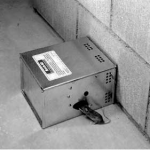I was so very fortunate early in my career to have an account that taught me aspects of pest control that some techs don’t get to see for years if they do at all. This one account taught me bird control, no baiting rodent service, grain fumigation, grain pest identification as well sanitation practices, dealing with government inspectors and proper communication. Keep in mind I was still a residential service person wet behind the ears when this account was shifted over to my route. I remember pulling into the parking lot the first and only day I was to train with the guy who had been doing it. There before us was this huge old time building that seemed to have 1000 windows and with it 5 or six even taller silos that stood like large castle towers. A river ran just behind it and the banks were covered with large jagged rocks. My trainer for the day looked at me and said with a hint of sarcasm, “You’re gonna have fun with this one.”
The first thing I noticed was this was a weekly account and I thought man they must have a lot of bugs. To my amazement when we unpacked our equipment for the job it didn’t include my trusty sidekick B&G sprayer. Instead we toted in buckets of Avitrol (corn based bait for pigeons) and an empty bucket but nothing else. By now I was confused because up to this point the most commercial work I had done were some tiny delis and an occasional office with a small warehouse.
Our first task was to check in with the operations supervisor and I’m sure he said something important but I was in awe of this huge bldg. and all the activity. Fork lifts were flying everywhere and conveyor belts moved endless streams of grain from one place to another and even up through a hole in the ceiling that was oh so high. There were hundreds of pallets stacked with thousands of bags filled with grain, all in a perfect row along every wall and in painted isle-ways and none were out of line, not even an inch. We put our Avitrol buckets in a locked storage room and both of us signed our names in a huge 3 ring binder book. I only caught a glimpse of the page but there were notes in columns and check marks in yes or no question boxes and some official looking red stamp in several spots on the page. I remember the supervisor looking at me as if sizing me up and I could tell he had his doubts if I could handle the job. Right there at that moment, I had my doubts too.
bldg. and all the activity. Fork lifts were flying everywhere and conveyor belts moved endless streams of grain from one place to another and even up through a hole in the ceiling that was oh so high. There were hundreds of pallets stacked with thousands of bags filled with grain, all in a perfect row along every wall and in painted isle-ways and none were out of line, not even an inch. We put our Avitrol buckets in a locked storage room and both of us signed our names in a huge 3 ring binder book. I only caught a glimpse of the page but there were notes in columns and check marks in yes or no question boxes and some official looking red stamp in several spots on the page. I remember the supervisor looking at me as if sizing me up and I could tell he had his doubts if I could handle the job. Right there at that moment, I had my doubts too.
We took our empty bucket and he led me behind the first row of pallets where we found a Ketch all rodent station surrounded by a bright orange steel frame anchored to the wall and floor. “This keeps the ketch all’s from being hit by a fork lift” he shouted over the  loud roar one such lift zooming by. “Pick it up, look in the holes-if you got a mouse shake it to knock him out and put him in the bucket and keep moving. I’ll do every other one.” Right then as if a gun went off to start a race he sprinted down the perfectly formed isle and we were checking, shaking, dumping and winding the traps like two mad men. Each one had a number and he didn’t tell me how many there were and I thought we’d never see the end even after we reached 100. All and all if memory serves me I think there were 143 traps, each one in it’s perfect orange frame and no more than 10 feet apart. I was surprised that we didn’t really get that many mice and killing the ones that weren’t dead already involved water and I’ll just leave it at that. We ended up at the desk with the big book where we documented how many mice, which stations, moth or beetle sightings and any sanitation recommendations. One of our nice orange frames did take a hit and you’d have thought the supervisor had just been told there was a bomb in the place. I think that thing was fixed before we ever left.
loud roar one such lift zooming by. “Pick it up, look in the holes-if you got a mouse shake it to knock him out and put him in the bucket and keep moving. I’ll do every other one.” Right then as if a gun went off to start a race he sprinted down the perfectly formed isle and we were checking, shaking, dumping and winding the traps like two mad men. Each one had a number and he didn’t tell me how many there were and I thought we’d never see the end even after we reached 100. All and all if memory serves me I think there were 143 traps, each one in it’s perfect orange frame and no more than 10 feet apart. I was surprised that we didn’t really get that many mice and killing the ones that weren’t dead already involved water and I’ll just leave it at that. We ended up at the desk with the big book where we documented how many mice, which stations, moth or beetle sightings and any sanitation recommendations. One of our nice orange frames did take a hit and you’d have thought the supervisor had just been told there was a bomb in the place. I think that thing was fixed before we ever left.
I thought maybe we were done with the mice and we grabbed our bucket and all I was told was it’s time to go up. We went to a doorway and I fully expected to see a stair case but instead there was a large conveyor belt coming up from a hole in the floor and going through a hole in the ceiling. There were metal handles on the belt followed by thick metal plates. “Grab a handle and step on a plate and don’t catch the bucket on the ceiling or we’ll have a mess!” my tutor said as he rose through the ceiling and disappeared. Wow, that to me was so cool and worth the 1000 yard dash we just ran so I latched on and up I went.
Much to my dismay the ride ended on the second floor where we signed into another big book and ran yet another mouse-a-thon but this one wasn’t so bad with maybe 90 stations. We also did the 3rd floor which had even less and the 4th floor had none but we still needed to inspect it each and every week. It was much quieter there and my guide finally filled me in on what the entire job entailed as we walked around. My legs were a bit wobbly and I’m not sure I could carry that bucket of corn much longer but I was excited that we were taking that great conveyor belt in the sky up to the roof where I would begin to learn another valuable lesson in commercial pest control.
this one wasn’t so bad with maybe 90 stations. We also did the 3rd floor which had even less and the 4th floor had none but we still needed to inspect it each and every week. It was much quieter there and my guide finally filled me in on what the entire job entailed as we walked around. My legs were a bit wobbly and I’m not sure I could carry that bucket of corn much longer but I was excited that we were taking that great conveyor belt in the sky up to the roof where I would begin to learn another valuable lesson in commercial pest control.




